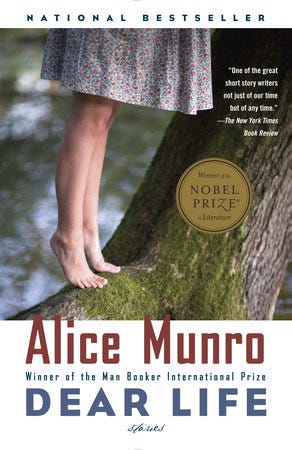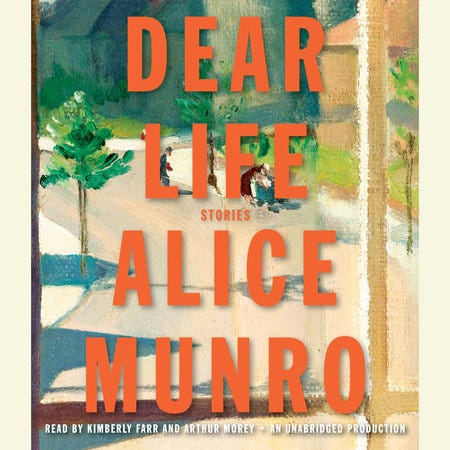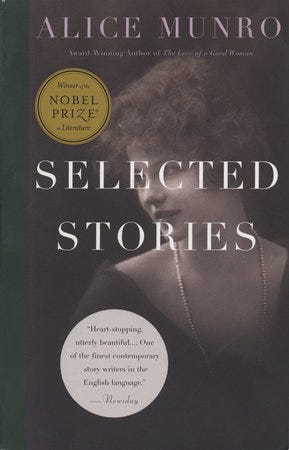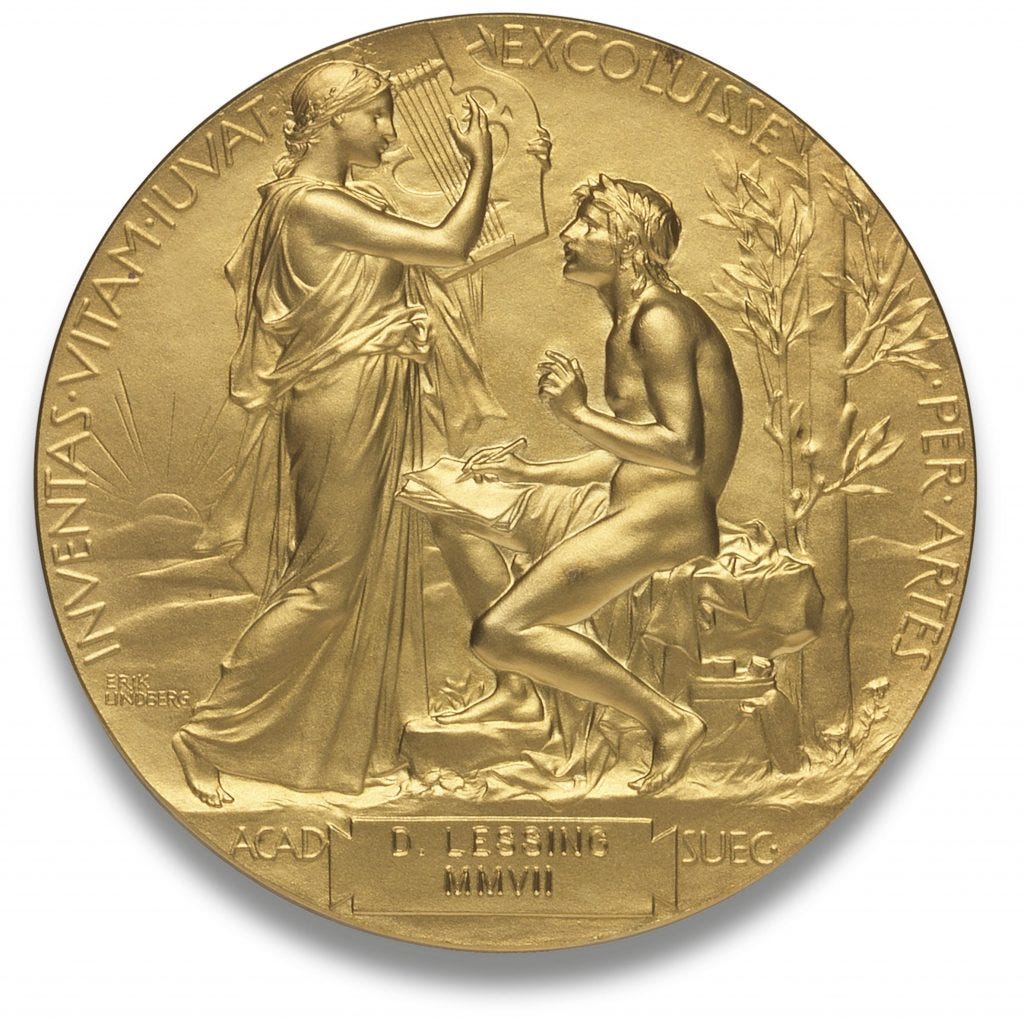What's So Great about Alice Munro?
Tips for reading and enjoying the late Nobel Laureate



July 9, 2024 Update - Two days ago Alice Munro’s youngest daughter went public with her history of child abuse at the hands of her mother’s second husband. The news came as a shock to most of Munro’s readers, though it was long known in the family and to some close professional associates. I provide detailed headnotes on this development at the Alice Munro Substack Virtual Memorial and my interview with biographer Robert Thacker. The post below addresses why readers have appreciated Munro’s storytelling style prior to the new knowledge of Andrea Skinner’s story. It appears from this point as originally published in June.
By now, regular readers of this newsletter know about the death last month of Canada’s first Nobel Laureate in literature. While Alice Munro has many devoted admirers around the world, it is not lost on me that readers of this newsletter may not count themselves in that number.
This post is for those of you who learned last week how Munro’s career began and are left asking, “Okay, so what about her writing? What’s so great about it?”
This post is for those who’ve read headlines calling her a “master of the short story,” and wondered, “What exactly does that mean? What’s the difference between a masterful short story and the rest of them?”
And this post is especially for you if you have read one or two stories by Munro and put down the book.
My goal in the next five or six minutes is to help Munro newcomers understand why she has so many admirers and has swept every literary prize in Canada and some small international prizes, too (Man Booker International, Nobel — little things). One of the most helpful services of a literary critic is to amplify the appreciation, enjoyment, and insight that readers derive from books. Whether you read Munro or not is up to you, but here are some tips that may expand your appreciation if you do.
A cumulative reputation
The first thing to know about Alice Munro is that her reputation did not depend on one or two hit stories with names everybody remembers. There is no signature character who recurs and defines her oeuvre. Many of her stories have single-word titles that tell you almost nothing about the content of the story: “Train,” “Comfort,” “Mischief.”
Munro’s reputation is based on her ability to draw readers into a deep state of emotional recognition in story after story, book after book.
Some people call her a regional, rural or Southwestern Ontario writer because many of her stories are set in her home county just east of Lake Huron, but she resisted the label of “regional writer.” She thought her characters were like people anywhere. Set in distinctly small-town places, her stories reach for what is universal about human feeling.
Why first impressions might put you off
Since there is no single book or story by Munro that everyone must read, you might start anywhere.
Lord help you if you start with “Privilege” in The Beggar Maid and outhouses make you squeamish. Or you start with “Family Furnishings” in Hateship, Friendship, Courtship, Loveship, Marriage and expect characters to stand for something, like feminism or independence, with consistency. Or you start with “Comfort” from the same collection and you like to be clear on what a story is actually about. In short, expectations formed from our reading of other writers might not help us through Alice Munro.
To put that another way, Munro drew the genre of the short story further from its nineteenth-century roots as a unity of character and incident. For comparison, consider Mark Twain’s famous tale, “The Celebrated Jumping Frog of Calaveras County.” In this story, the narrator has been sent by a friend to ask a question of a long-winded chatterbox in a western mining camp, Simon Wheeler. Each character has a dominant feature: unsuspecting trust for the narrator, garrulity for Simon Wheeler. In the confrontation between these two character traits, a humorous story occurs. In a traditionally plotted story, we take pleasure in watching the plot unspool as a consequence of character.
This sometimes happens in a Munro story, and some of her fans love her for exactly the way she can fulfill genre expectations and surprise us with twists at the same time. (The title story “Hateship, Friendship, Courtship, Loveship, Marriage” does this. Each character has acquired a certain social role and expectation, and what follows from character actions is both consistent with that social role and surprising.)
But more often, her stories simply drop in on a character and observe with penetrating emotional truth.
Munro and Chekhov
For this reason, the writer most often likened to Munro is Anton Chekhov, the late nineteenth-century Russian physician, playwright, and short story writer known for spare “slice of life” fictions. Chekhov presented characters with commonplace desires and refrained from judging them as good or bad. He simply observed their motivations and actions.
Munro’s stories similarly privilege detailed observation over genre conventions and narrative judgments. The later story “Free Radicals” (2008), for example, provides a good example of Munro’s tendency to observe characters without judging them, and without letting genre conventions prescribe the development of action. This story opens slowly on the widowed Nita’s listlessness after her husband’s death. She tells friends she is okay, but her spirit is lackluster. She has just enough energy to open the doors to let air in the midsummer house, and from such a tiny action, incidents develop. What begins as a slow-moving, Chekhovian story, suddenly feels like something else.
When she opens the door a crack, the slow sketch of a widow’s inner life appears to shift into another kind of story — a thriller. (The illustration of a prominent knife and a bloody china cup in The New Yorker supports the reader’s experience of the story as a thriller.)
There is a man at the door, introduced with a combination of a thriller’s ominous surprise and simple realism:
And even before she had allowed half an inch of morning light to show itself she was aware of a dark stripe cutting that light off.
There was a young man standing outside the screen door, which was hooked.
What is happening here?
What kind of story is this?
Before long, the widow, Nita, is making eggs and tea for the man — signs of a pleasant scene of rural realism. He shows her a picture and tells a story about it that causes her to feel her life is in danger. He breaks a dish and refuses to let her touch the knives or any glass. Back and forth, the story vacillates between rural realism and thriller suspense, edging further and further into the latter.
I won’t tell you how the story ends, but I will tell you that both main characters, Nita and the man, are sympathetic, and both have caused harm. We can only imagine the harm through inferences and stories. It is not the purpose of the story to judge their moral character, but only to see what happens when they meet in a certain way at a certain time.
As if to keep the characters free, Munro mixes genre conventions so that we are kept guessing: What is happening here? What kind of story is this? As in real life, we cannot be sure of the future. We can only observe what these plausible people do.
“To find out what I can see”
Munro provided a glimpse of the engine that drives her stories in a 2004 interview with host Eleanor Wachtel for CBC Radio One, just after her book Runaway was released. “I am so involved in everything that I’ve lived,” Munro told Wachtel, “that I never want to let go of it until I’ve done something with it — and that is not just to write and sell a story but to see — and to find out what I can see in it.”
In a typical Alice Munro story, lightly plotted and deeply described, readers also find out what we can see in commonplace characters and everyday events. We may begin to form expectations about where a character or story is going, but then it does not go there. “I like when stories turn out in an unexpected way that doesn’t seem forced,” she explained in the same 2004 interview. In her favorite story outcomes, “life has a mind of its own.”
Munro’s fiction takes us deeply, lingeringly into the awkwardness, boredom, indecision, uncertainty, and mixed feelings with which we live, and finds tiny elements of surprise and sometimes humor in the most mundane places. Teens curious about each others’ bodies in Lives of Girls and Women leave a girl in an awkward situation. A woman riding home from an oncology appointment is bored but tolerant of stops along the way in “Floating Bridge,” but when an offer comes to go home, she takes it. These tiny ripples of the unexpected become invitations “to find out what I can see” in ordinary curiosity, boredom, impatience, and other feelings.
To enjoy Munro, do not ask, “How will this plot be resolved?” Instead, ask, “What is there to see in this situation?” This shift may help you read as if over Munro’s shoulder.
So when you pick up your next Alice Munro story, watch for a tiny ripple of the extraordinary in the ordinary — like a mirage vibrating off the hot pavement. Watch how authentically she conveys everyday life and speech so that you might almost be lulled into thinking that nothing extraordinary is happening in the story —
And nothing extraordinary is happening to you in the utterly ho-hum, outward stillness of your reading.
Coming up Thursday
Join the Alice Munro virtual memorial with your own essay, story, or note about Alice Munro this Thursday, June 13, one month after her death.
On Thursday from this publication, subscribers will receive a copy of my interview with Munro biographer Robert Thacker about his insights and anecdotes from fifty years of reading Munro.
Watch the Quiet Reading home page to see links to memorial tributes as they are posted in real time on Thursday. Or subscribe to Quiet Reading to receive the complete memorial post next Monday as the culmination of this month of Munro.





Tara- Thanks for introducing me to her fantastic work and story. This is a great find.
Answer-Her amazing stories^^